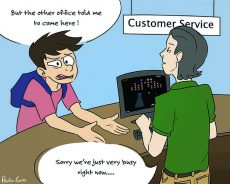Hourlong phone calls complete with static and automated option menus fill the modern-day customer service experience.

Seldom do real humans answer the phone. When they do, they barely seem like real people. These employees aren’t programmed to be understanding or empathetic. They are taught to read from a script like robots, just getting through as many calls as possible before lunch.
Companies simply aren’t training their employees to care enough about their jobs and the greater repercussions that can follow a customer service blunder.
The golden age of the internet and viral videos allows for keyboard warriors to point out these social injustices. In some cases, this can cost a company quite a bit of money.
Recently under fire in the biggest PR nightmare this year is United Airlines.
A passenger was dragged from his seat on the plane after room needed to be made for four employees. He suffered a broken nose, a concussion and the loss of two front teeth.
Passengers were recording, and after the videos went viral, the stock value for United dropped $1.4 billion.
In this situation, the employees should have been put on another flight. The customer’s experience should be the most important thing, seeing as that is the sole reason a company exists.
This is not the first time United’s customer service has been in question, however. In 2009, musician Dave Carroll flew United, and his $3,500 guitar was thrown by baggage handlers. The guitar was severely damaged, and the airline refused to compensate him.
Carroll then wrote three songs and put the videos on YouTube. The first of the videos has more than 17 million views.
The indifference of employees is a scary reality for more businesses than just United. We as a society have grown to accept and expect the robot way of customer service, and that is something that needs to change.
Treating people and their experiences as valid is important to the success of any business, so the employees should be trained to do so.
Everyone deserves to be treated as a human being, and that’s at the heart of real customer service.
The Ritz-Carlton is an example of how customer service should be handled and should give people hope that good service is out there somewhere.
A family stayed at the hotel and, upon their checkout, had realized they had left their son’s favorite stuffed animal. They told their young son that the giraffe was just enjoying an extended vacation.
The hotel called that night to inform the family they had it. The dad asked if they could take a picture of the giraffe by the pool to verify his story, and the hotel’s actions completely exceeded their expectations.
The loss prevention team sent the stuffed animal back with Ritz-Carlton branded gifts and a binder filled with pictures of the giraffe’s extended stay at the hotel.
The loss prevention team’s response to the simple request is how it should be handled and ultimately acts as a good role model for other companies, especially in the service industry.
Customer service needs a reboot and one that involves fewer robots.

